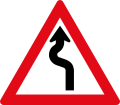Top Qs
Timeline
Chat
Perspective
Roads in Botswana
Overview of roads in Botswana From Wikipedia, the free encyclopedia
Remove ads
Botswana has a network of roads, of varied quality and capacity, totaling about 31,747 kilometres (19,727 mi). Of these, 20,000 kilometres (12,000 mi) are paved. This includes 134 kilometres (83 mi) of motorways.[1] The remaining 11,747 kilometres (7,299 mi) worth of roads are unpaved. Road distances are shown in kilometers and Botswana speed limits are indicated in kilometers per hour (kph) or by the use of the national speed limit (NSL) symbol. Some vehicle categories have various lower maximum limits enforced by speed limits, for example trucks.[2]
This article may be in need of reorganization to comply with Wikipedia's layout guidelines. (July 2022) |

Remove ads
Classification
Summarize
Perspective
Administration
Responsibility for the road network differs between trunk and non-trunk routes. Trunk roads, which are the most important roads, are administered by the Ministry of Transport.[3][4] The classifications of A and B roads are independent of their width and quality. Some B roads are wide enough to accommodate bidirectional traffic, while others are narrower with various passing locations. B roads follow the same numbering scheme as A roads, but almost always have 3- and 4- digit designation.[5]
A roads
A roads are highways and other major roads.
B roads
B roads are distributor roads, which see less traffic than A roads.
Motorways
Motorways in Botswana have a set of restrictions, which prohibit certain traffic from using the road. The following classes of traffic are not allowed on Botswana motorways:
- Learner drivers
- Slow vehicles (i.e., not capable of reaching 60km/h on a level road).
- Invalid carriages (lightweight three-wheeled vehicles)
- Pedestrians
- Pedal-cycles (bicycles, etc.)
- Vehicles under 50cc (e.g., mopeds)
- Tractors
- Animals
Rules for driving on motorways include the following:
- The keep-left rule applies unless overtaking
- No stopping at any time
- No reversing
- No hitchhiking
- Only vehicles that travel faster than 80km/h may use the outside lane
- No driving on the hard-shoulder
Signage
Signage on the Botswana network conforms broadly to Southern Africa norms, though a number of signs omit Southern Africa route numbers. All length distances are shown in kilometers, speed is in kilometers per hour whilst height and width restrictions are required to be shown in feet and inches (though the metric measurements may optionally also appear).


Traditionally, road signs in Botswana used blue backgrounds rather than the yellow, white, or orange that the rest of the world uses on traffic warning signs. In the early 2010s, officials announced plans to begin phasing out the distinctive blue signs in favor of more typical signs in order to be more in line with the neighboring Southern African Development Community member states.[7]
Remove ads
See also
References
External links
Wikiwand - on
Seamless Wikipedia browsing. On steroids.
Remove ads
